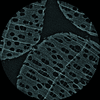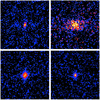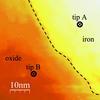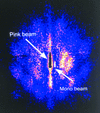issue contents
September 2020 issue

Cover illustration: Three-element false-colour composite elemental map of a Portuguese millipede (Ommatoiulus moreleti) measured with the Maia 384 detector array at the X-ray Fluorescence Microscopy beamline at the Australian Synchrotron (see Howard, de Jonge, Afshar, Ryan, Kirkham, Reinhardt, Kewish, McKinlay, Walsh, Divitcos, Basten, Adamson, Fiala, Sammut and Paterson, pages 1447–1458).
facility information
research papers
Open  access
access
 access
accessThe possibilities to perform serial synchrotron crystallography at BioMAX, the first macromolecular crystallography beamline at MAX IV Laboratory in Lund, Sweden, are described, together with case studies from the synchrotron X-ray crystallography user program.
Open  access
access
 access
accessA monolithic Wolter-type mirror with large acceptance, achromatism and small comatic aberration was designed and evaluated at the soft X-ray beamline BL25SU of SPring-8.
Open  access
access
 access
accessThe OASYS suite is used to implement a ray-tracing algorithm to calculate the thermal load in undulator-based synchrotron beamlines. The algorithm is particularly suited to analyze cases with complex beamline layout and optical elements. Examples of its use on two of the feature beamlines at the Advanced Photon Source Upgrade Project are shown.
Open  access
access
 access
accessSpherical aberrations in nanofocused X-ray beams generated by beryllium compound refractive lenses at 8.2 keV and 35 keV are corrected via refractive phase plates fabricated by subtractive and additive technology.
Open  access
access
 access
accessA cantilevered liquid-nitrogen-cooled silicon mirror is described that will achieve diffraction-limited performance even under extreme power density. This mirror will serve as a robust first optic for the high-brightness undulator beamlines at the upgraded Advanced Light Source.
A simple and complete one-dimensional wavefront propagation model for beamline analysis is developed in the WOFRY package in OASYS. It is used to analyze how the thermal load of the white-beam mirror degrades the wavefront. This can be corrected by an adaptive mirror, with some limitations that are studied.
Open  access
access
 access
accessThe ambient-pressure endstation of the VerSoX beamline (B07) of Diamond Light Source provides a versatile facility for soft X-ray absorption and photoemission measurements in the mbar pressure range. A selection of typical data demonstrates the capability of the instrument to analyse details of the surface composition of solid samples and the environment gas under ambient-pressure conditions.
Open  access
access
 access
accessAn azimuthal-rotation sample holder, with improvements in the rotation-angle accuracy and rotation-axes displacement during azimuthal rotation, was developed for molecular-orientation analysis using scanning transmission X-ray microscopy.
Open  access
access
 access
accessA data-driven approach has been developed to correct scattering data for X-ray response non-uniformity in microstrip detectors on demand. The present study will facilitate the correction in all types of X-ray detectors.
In this work, the room-temperature performance of 3 mm-thick cadmium–zinc–telluride (CZT) pixel detectors with sub-millimetre arrays is presented. The detectors allow high-bias voltage operation (6000 V cm−1 electric field) with energy resolution values of less than 2 keV up to 140 keV.
Open  access
access
 access
accessThe Diamond Radial In Situ X-ray (DRIX) cell for combining electrochemical cycling with total scattering measurements is presented and applied to X-ray pair distribution function and X-ray Raman scattering studies on the high-capacity cathode material Li4Mn2O5.
Open  access
access
 access
accessTo unveil the origin of radiation damage, a comparison was made of nanoprobe X-ray diffraction experiments carried out on individual semiconductor nanowires in their as-grown geometry both under ambient conditions and under He atmosphere at the microfocus station of the P08 beamline at the third-generation source PETRA III. Nanowires exposed under ambient conditions show severe optical and morphological damage, which was reduced for nanowires exposed under He atmosphere.
Open  access
access
 access
accessA high-temperature setup is presented for in situ synchrotron scattering experiments on thin films, including high heating rates and atmosphere control.
Soft X-ray-induced radiation damage was studied by FTIR microscopy in thin freeze-dried brain tissue samples mounted onto Si3N4 membrane windows. In addition to degradation of molecular assemblies in the tissue, the irradiation was discovered to induce detectable and reversible Si protonation in the Si3N4 substrate, not visible in polymeric model samples.
Crystals in non-coplanar asymmetric X-ray Bragg diffraction can function as high-reflectance soft-X-ray diffraction gratings with dispersion rates that are at least two orders of magnitude larger than those that are possible with state-of-the-art man-made gratings. This opens new opportunities to design and implement soft X-ray resonant inelastic scattering spectrometers.
Open  access
access
 access
accessRIXS spectra are invariant to their integration over incident-photon energies within the core-hole lifetime. With hv2 spectrometers, the whole lifetime-wide bandwidth of synchrotron radiation can be utilized without compromising the energy resolution of the RIXS spectra.
A versatile strategy to perform efficient X-ray magnetic circular dichroism experiments with a quarter-wave plate using a setup that combines non-conventional dispersive optics with locked-in acquisition, also compatible with monochromatic X-ray beamlines and large magnets, is reported.
Open  access
access
 access
accessAnalysis of the X-ray beam-induced dynamics in oxide glasses probed by X-ray photon correlation spectroscopy is presented. The results offer the possibility to estimate true sample relaxation time by performing two measurements with different X-ray fluxes.
A very simple non-destructive total reflection X-ray fluorescence (TXRF)-based methodology has been developed for trace as well major elemental determinations in zirconium alloy samples. Its originality mostly relies on the proposed novel methodology that a solid material of high purity, such as Zr-based alloys (in this application), can be quantitatively analyzed with respect to the content of its major, minor and trace elements, by means of synchrotron-radiation-based TXRF spectrometry without requiring the cumbersome dissolution of such samples.
High-accuracy measurement of attenuation coefficients and XAFS to 0.13% for ZnSe using the X-ray extended range technique, at 561 energies from 6.8 keV to 15 keV, determining bond lengths and possible dynamic motion.
The self-assembly kinetics of a lamellar block copolymer are accurately characterized in situ and in real time using grazing-incidence small-angle X-ray scattering. A novel modelling methodology is implemented for the determination of self-assembly kinetic parameters by properly considering the initial annealing conditions for both isothermal and non-isothermal processes.
A performance analysis of the X-ray excited optical luminescence of a substrate as a detection mode of the soft X-ray absorption spectra of a thin film on top is presented.
Open  access
access
 access
accessEvaluation of remote direct memory access data transfer from an X-ray detector head into a remote-processing graphics processor unit in the scope of a synchrotron serial crystallography experiment performed at 1000 images s−1.
Open  access
access
 access
accessA genuine representation of the cross-spectral density function is applied to model partially coherent wave propagation in X-ray imaging systems.
Open  access
access
 access
accessA new method for time-resolved scanning transmission X-ray microscopy imaging, to measure the time-of-arrival of the X-ray photons, is presented. This method promises an improvement in the time resolutions achievable with normal optics filling patterns.
Open  access
access
 access
accessSynchrotron beamlines acquiring data for tomographic imaging routinely produce a few TB of data per day, and significantly more in the case of time-resolved studies. This work investigates the impact of lossy compression of raw acquisitions onto tomographic reconstructions, aiming for production use. It is shown that a compression factor of at least three to four times does generally not affect the reconstruction quality and that higher factors (six to eight times) can be achieved for tomographic volumes with a high signal-to-noise ratio as it is the case for phase-retrieved datasets.
Open  access
access
 access
accessUnique transmission X-ray microscopy geometry allows high temporal resolution in absorption as well as phase contrast nanotomography. The evaluation of fast scan times versus image quality is presented.
Details of the implementation of a new tomographic station for pink-beam imaging at the biomedical beamline ID17 of the European Synchrotron are reported. An overview of the preliminary results obtained using this station is included within this work.
short communications
A feasibility study was performed involving phase-contrast X-ray imaging combined with a crystal X-ray interferometer and the free-electron laser at the SPring-8 Angstrom Compact Free-Electron Laser; X-ray interference patterns and a phase map were successfully obtained.
The pulse duration of soft X-ray free-electron laser pulses was characterized using the cross-correlation technique.
Open  access
access
 access
accessA focus characterization method using the intensity correlation of X-ray fluorescence is proposed, and demonstrated for the sub-micrometre focused X-ray free-electron laser beam at the SPring-8 Angstrom Compact Free Electron Laser.
The pressure effects on the Debye frequency and EXAFS Debye–Waller factor of iron metal based on the Debye model are investigated. Numerical calculations are performed up to a pressure of 220 GPa and compared with those of previous works when possible.
Synchrotron SAXS was used in situ during collagen denaturation to study the effects of natural and synthetic chemical crosslinks.
beamlines
An ultra-high-vacuum compatible chopper system for operation at soft and hard X-ray photon energies, a necessary component in synchrotron X-ray scanning tunneling microscopy, has been developed.
The design and performance test of the vacuum ultraviolet beamline BL03U at SSRF are described.
Open  access
access
 access
accessThe multipurpose X-ray beamline of the Munich Compact Light Source, a compact synchrotron radiation facility based on an inverse Compton X-ray source, is presented including its design and instrumentation. Its wide range of capabilities is discussed based on application examples ranging from spectroscopic as well as phase-contrast X-ray imaging and tomography to X-ray absorption spectroscopy or micro-beam radiation therapy research.
Open  access
access
 access
accessBioMAX is the first macromolecular crystallography beamline at the first fourth-generation storage ring, the 3 GeV storage ring at MAX IV Laboratory. It is a highly automated, user-friendly, microfocus beamline that provides excellent performance for most macromolecular crystallography applications.
Open  access
access
 access
accessThe commissioning of a movable X-ray monochromator at the 34-ID-C endstation of the Advanced Photon Source is reported. The new instrument allows indexing of nanocrystals with Laue diffraction and collecting multi-reflection BCDI data.
Open  access
access
 access
accessThe B21 beamline at Diamond Light Source is optimized for automated measurement of small-angle X-ray scattering from solution samples.
The X-ray fluorescence microscopy (XFM) beamline at the Australian Synchrotron specializes in the spatially resolved detection and speciation determination of elements at the micrometre length scale. The status of its various operational modes and future upgrades are presented.


 journal menu
journal menu





























































